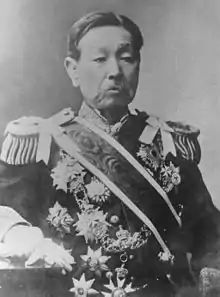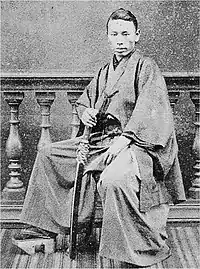Inoue Kaoru
The Marquis Inoue Kaoru (井上 馨, January 16, 1836 – September 1, 1915), GCMG was a Japanese politician and a prominent member of the Meiji oligarchy during the Meiji period of the Empire of Japan. As one of the senior statesmen in Japan during that period, he had a tremendous influence on the selection of the nation's leaders and formation of its policies.
Marquis Inoue Kaoru 井上 馨 | |
|---|---|
 The Marquis Inoue Kaoru | |
| Minister for Foreign Affairs of Japan | |
| In office 22 December 1885 – 17 September 1887 | |
| Preceded by | none |
| Succeeded by | Itō Hirobumi |
| Minister of Agriculture and Commerce | |
| In office 25 July 1888 – 23 December 1889 | |
| Preceded by | Kuroda Kiyotaka |
| Succeeded by | Iwamura Michitoshi |
| Home Minister | |
| In office 8 August 1892 – 15 October 1894 | |
| Preceded by | Kōno Togama |
| Succeeded by | Nomura Yasushi |
| Finance Minister | |
| In office 12 January 1898 – 30 June 1898 | |
| Preceded by | Matsukata Masayoshi |
| Succeeded by | Matsuda Masahisa |
| Personal details | |
| Born | January 16, 1836 Yuda, Chōshū Domain, Japan |
| Died | September 1, 1915 (aged 79) Shizuoka, Japan |
Early years

Born Yakichi (勇吉) to a lower-ranked samurai family in Yuda, Chōshū domain (present day Yamaguchi, Yamaguchi Prefecture), Inoue attended the Meirinkan domain school with his brother Ikutarō (幾太郎). He was a close boyhood friend of Itō Hirobumi who later became Japan's first prime minister, and he played an active part in the sonnō jōi movement. In 1858, he studied rangaku, artillery and swordsmanship in Edo.
In the Bakumatsu period, Inoue emerged as a leader of the anti-foreigner movement in his native Chōshū. Desiring to rid Japan of foreigners, he and Takasugi Shinsaku set fire to the British legation in Edo in January 1863.
Recognizing Japan's need to learn from the Western powers, Inoue joined the Chōshū Five and was smuggled out of Japan to study at University College, London[1][2] in England in 1863. When he returned with Itō Hirobumi, he unsuccessfully tried to prevent war (the Battle of Shimonoseki) between Chōshū and the Western naval powers over the closing of the Straits of Shimonoseki to foreign shipping. Later, he fought against the forces of the Tokugawa shogunate in the 1864 First Chōshū Expedition, during which he was severely wounded by the attack of the assassins, received a near-fatal injury, appealing to Inoue's elder brother for beheading because of the unbearable pain and finally Ikutaro Tokoro (jp) who was then in hiding from the pursuit of Tokugawa shogunate with Prince Sanjō Sanetomi and rushed to Inoue pulled him through this by putting about 50 stitches of tatami needle in the wounds on the whole body without anesthesia because of emergency during the domestic war time (The story that Inoue's mother holding bloody Inoue then dissuaded her elder son from beheading was introduced in the National Japanese text book of the 5th period as the power of mother).[3] He later played a key role in the formation of the Satchō Alliance against the Tokugawa shogunate.
Statesman in the Meiji government
After the Meiji Restoration, Inoue served in several important positions in the new Meiji government. He was appointed Vice Minister of Finance in 1871 and was influential in reorganizing government finances on modern lines, especially in the reform of the land tax system, termination of government stipends to the ex-samurai and former aristocracy and for promoting industrialization. Closely linked to business circles, including the emerging Mitsui zaibatsu, he was also involved in the railway business. These measures created many political enemies, and Inoue was forced to resign in May 1873. Inoue took part in the Osaka Conference of 1875 to support the creation of a representative national assembly.
In 1876, Inoue was asked to assist in the field of foreign affairs, and was involved in the conclusion of the Japan-Korea Treaty of 1876 as vice-ambassador extraordinary and plenipotentiary. He returned to government as Minister of Public Works in 1878 and Lord of Foreign Affairs in 1879 under the early Meiji Dajō-kan Cabinet. In 1884, he was elevated to the rank of count (hakushaku) under the new kazoku peerage system.
In December 1885, Inoue officially became Japan's first Minister of Foreign Affairs bearing that title in the first Itō Hirobumi cabinet. However, Inoue came under public criticism for his failure to negotiate a revision of the unequal treaties, his building of the Rokumeikan, and support of its Westernizing influences, which forced him to resign in August 1887.
Later he served as Minister of Agriculture and Commerce in the Kuroda administration, as Home Minister in the second Itō administration and again as Finance Minister in the 3rd Itō administration.
From 1901 onwards, Inoue served as most senior of the genrō, and considered himself the government's foremost advisor on financial affairs. He was advanced to the title of marquis (kōshaku) in 1907, and died in 1915 at his summer home at Okitsu-juku, Shizuoka prefecture.
Honours
From the article in the Japanese Wikipedia
Japanese
- Grand Cordon of the Order of the Rising Sun (February 10, 1879)
- Count (July 7, 1884)
- Grand Cordon of the Order of the Rising Sun with Paulownia Flowers (October 7, 1895)
- Grand Cordon of the Order of the Chrysanthemum (April 1, 1906)
- Marquess (September 21, 1907)
- Collar of the Order of the Chrysanthemum (September 1, 1915; posthumous)
Foreign
- Honorary Knight Grand Cross of the Order of St. Michael and St. George (GCMG) (February 20, 1906)[4]
- Grand Cross of the Legion of Honour of France
References
- (in Japanese) Prime Minister Shinzō Abe visited UCL and the monument of Chōshū Five therein | Ministry of Foreign Affairs of Japan
- PM Abe visits the monument to commemorating the ‘Choshu Five’ | Prime Minister Abe’s visit boosts Japan-UK relations
- Tokoro Ikutaro, masterless samurai who became staff officer of Takasugi Shinsaku and saved the life of Inoue Kaoru : Sankei News
- London Gazette, 15 May 1906
Further reading
- Akamatsu, Paul. (1972). Meiji 1868: Revolution and Counter-Revolution in Japan (trans., Miriam Kochan). New York: Harper & Row.
- Beasley, William G. (1972). The Meiji Restoration. Stanford: Stanford University Press.
- __________. (1995). The Rise of Modern Japan: Political, Economic and Social Change Since 1850. New York: St. Martin's Press.
- Craig, Albert M. (1961). Chōshū in the Meiji Restoration. Cambridge: Harvard University Press.
- Jansen, Marius B. and Gilbert Rozman, eds. (1986). Japan in Transition: from Tokugawa to Meiji. Princeton: Princeton University Press. ISBN 9780691054599; OCLC 12311985
External links
 Media related to Inoue Kaoru at Wikimedia Commons
Media related to Inoue Kaoru at Wikimedia Commons- National Diet Library bio
- . Encyclopædia Britannica (11th ed.). 1911.
| Political offices | ||
|---|---|---|
| Preceded by none |
Minister for Foreign Affairs of Japan Dec 1885 – Sept 1887 |
Succeeded by Itō Hirobumi |
| Preceded by Kuroda Kiyotaka |
Minister of Agriculture and Commerce Jul 1888 – Dec 1898 |
Succeeded by Iwamura Michitoshi |
| Preceded by Kōno Togama |
Home Minister Aug 1892 – Oct 1894 |
Succeeded by Nomura Yasushi |
| Preceded by Matsukata Masayoshi |
Finance Minister Jan 1898 – Jun 1898 |
Succeeded by Matsuda Masahisa |